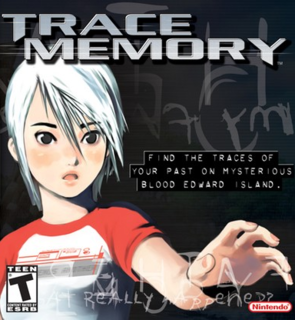Trace Memory is one of the first truly enjoyable games that incorporates most of the abilities that the DS has to offer.
To start, it should be said that Trace Memory is one of the only adventure titles available on the DS. With all of the pressure placed upon the game as being a leader in its genre, I'm happy to report that it does not disappoint. The gameplay is smooth right out of the box, with little time needed for explanations. The touch screen can be used exclusively, or just when the game actually demands it, and either form of control (D-Pad of otherwise) is very fluid and intuitive. The story that you are navigating through also deserves hefty praise.
You play as 13-year-old Ashley Robbins, on a desperate search for your father (whom you earlier presumed dead) after receiving a letter stating otherwise. Your search, on Blood Edward Island, will take you through various gardens, near mine shafts, through a large mansion expanse, and even into an underground cave.
Towards the beginning of this journey you come across D, a ghostly figure who is suffering from a severe case of amnesia. You both have the same goal, to find out what happened in your pasts, and as such, D joins you on your way. This is where the story in Trace Memory really begins to shine, with both a main and sub-plot to eventually explore.
Puzzles abound, and break up the seemingly repetitive nature of the "enter room, find something, leave room, rinse and repeat" system. These puzzles are great ways of showing the player the expanse of capabilities in the DS's arsenal. There are the obvious "stroke, scratch, rub" puzzles, plus a few "blow into the mic" puzzles as well. There is even a puzzle that requires you to physically tilt your DS to cast a reflection of the top screen onto the touch screen to receive a clue. While most of these puzzles are fairly easy, there are actually a couple of instances that had me momentarily thinking "Huh? What do I do now?" which, of course, made the solving of said instances even more gratifying.
Blood Edward Island is a deserted plot of land, and the graphics represent this fact well. You play the game from an overhead view, but the top and bottom screens change, independently of one another, when there is something of interest in front of you. These still photos are very nicely done, and it is obvious that the home is in a state of disrepair and misuse. Dust covers many objects, allowing your mic to come into play on a few instances when you need to blow the dust off. One of the best things about the graphics, however, is the fact that in Ashley's possession is a DS looking device called a DTS, which contains a camera. You can, and will have to, use this camera to take pictures of your surroundings, which can then be laid on top of one another to find hidden messages, like codes and so forth.
The sound department also fares well. The music is calming and tranquil, which matches the deserted yet homey feel of the mansion which you will be spending the majority of gameplay exploring. There are no fights and no ways to die, so dramatic music wouldn't even be necessary. The latter fact alone makes this title great for the casual gamer in all of us.
You can easily get through Trace Memory in a couple of sittings, or one very long car trip (around four hours of gameplay in total). Unfortunately, there aren't many extras, and you may initially feel like the ending was anti-climactic, which is my one complaint about the game.
The story with Ashley does indeed become resolved, but D's doesn't seem to end as nicely. It would have been better to see the depth of the rest of the title take a role in the ending as well. However, after playing the game through a second time, you will notice some slight differences, which help keep the story interesting. With a plot this intriguing to begin with, it definitely merits a second (or third) go around.
In the end, Trace Memory is one of the first truly enjoyable games that incorporates most of the special quirks and abilities that the DS has to offer. And now that most stores are starting to lower their asking price for Trace Memory (even to the point of putting it on the clearance rack), it would be a crime not to pick it up.
Review text part of GrrlGamer.com Full review and screenshots at:
http://www.grrlgamer.com/review.php?g=tracememory

